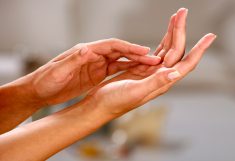Many drugs are available in a variety of strengths, and sometimes there isn’t much difference in price between different strengths. For example, 30 tablets of a five mg and 10 mg tablet may have similar prices. It follows that by breaking the 10 mg tablets in half, you would have 60 doses of five mg while paying a lower price.
But there may be problems.
One recent report shows some of these. A woman who was taking the blood pressure medication lisinopril started with the dose of 20 mg twice daily. Then, when her physician lowered her dose to 10 mg twice daily, she had her new prescription filled. However, not wanting to waste the remaining 20 mg tablets, she cut them in half and put them in the same bottle as the 10 mg tablets.
Read Also

Summer Series: Why it’s important for you to get fit
So much of farming is so physically demanding. Even the easy jobs take enough running around to require physical stamina….
Later, her physician lowered her dose again to five mg twice daily, but she didn’t fill this prescription. She simply went back to her vial to break her tablets. This time, though, she didn’t separate out all the original halves, so she ended up with pills that looked the same but had different amounts of the active ingredient.
Unfortunately, she had to be admitted to hospital and no one was sure what dose she had been taking.
The moral of the story is to be very careful if you are considering splitting tablets. Leave the original tablets in their original vials, and make a careful note of what you actually did, for example that you broke 20 mg tablets in half so that one-half tablet is 10 mg.
Some tablets have an odd shape and do not break easily. In the example, lisinopril has an oval shape, not round, and breaking these tablets in half is difficult. The split tablet may not break evenly, so one half will contain more of the active drug than the other.
Cutting tablets in half with a kitchen knife is never recommended as it is not accurate and can be difficult. Pill splitters are available which make the job a lot easier. If manual dexterity is a problem, your pharmacist may be able to split your tablets for you, but make sure that your label reflects that the tablets are already halved, or make a note that they are.
In a study by the U.S. Department of Veterans Affairs, researchers found that two-thirds of people who were taking half tablet doses took too much medication because they forgot to split their tablets. So, if you are taking a half tablet dose, don’t forget to break your tablet.
Be aware too that once tablets are split, they more readily crumble. Plus, splitting tablets can actually destroy some formulations.
Capsules and gel caps obviously cannot be broken, but enteric coated and sustained release formulations should not be broken either. Enteric coated tablets have a specialized coating that releases their medication at the correct site in your gastro intestinal tract. For instance, enteric coated acetylsalicylic acid or ASA is coated so that on its way to the small intestine where it is absorbed, it passes through the stomach where it could cause stomach irritation.
Sustained, extended, controlled, or slow-release formulations use technology to release specific amounts of their active ingredient(s) over time. By breaking these tablets, the technology is damaged and all the medication is released at once, which is not desirable Look for XR, LA, CR, XL, SR, or ER in the drug name.
One example you may know is Oxyconti, where the “contin” refers to a sustained release formulation. This pain reliever is intended to be taken twice daily to control pain. However if it is broken, all the drug is released immediately. Drug abusers know this. They crush the tablets for an instant “high.”
Sublingual or “under the tongue” tablets and orally dissolving tablets (ODT) do not break easily, but rather shatter or melt, and tablets that combine two or more ingredients may have specific layers or a core that can be damaged with breaking.
While splitting tablets does seem a good idea, check with your pharmacist first to ensure it won’t damage your medication. Saving money is a good thing, but keeping healthy is even better!














